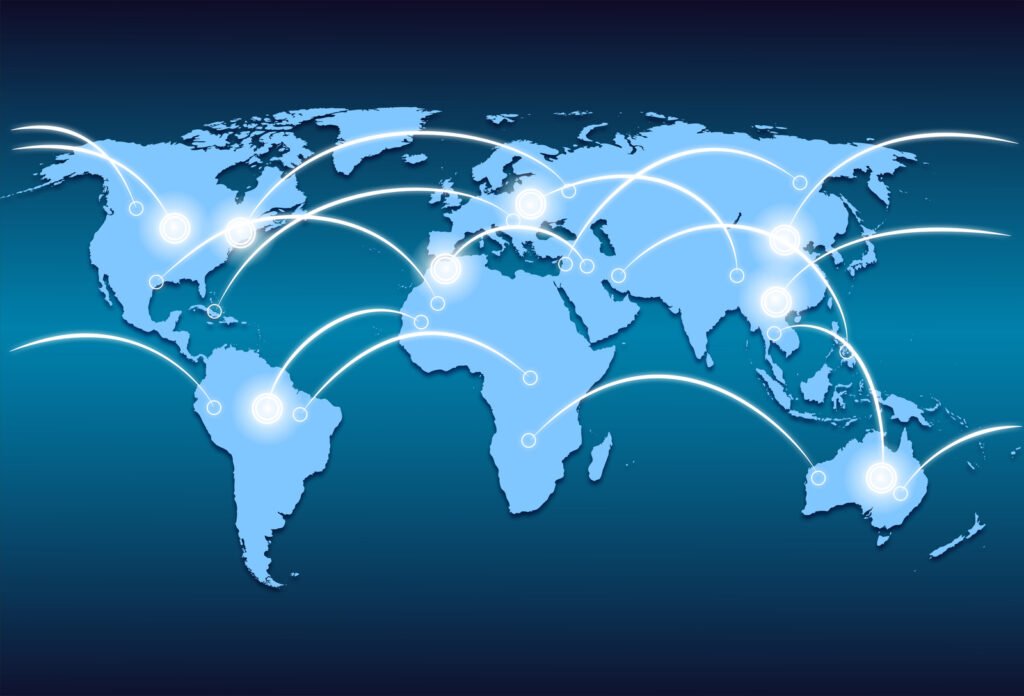You might think the Internet and World Wide Web are the same thing. They’re not. Understanding the difference between the internet and world wide web is key to grasping how online networks function.
The internet is a vast network of connected computers, while the World Wide Web is a system for accessing information over the internet. This distinction is crucial when discussing global information systems and how we interact with them daily.
In the following sections, we’ll explore the internet vs. www debate, clarifying their unique roles in our digital world. You’ll learn how these technologies shape our online experiences and why knowing the web vs. internet difference matters.
Introduction to Internet and World Wide Web

The digital age has transformed how we communicate, work, and live. At its core are two fundamental technologies: the Internet and the World Wide Web. Let’s explore these concepts and clear up some common misunderstandings.
Defining the Internet
The Internet is a vast network of interconnected computers spanning the globe. It forms the backbone of our digital infrastructure, enabling data transmission through various network protocols. This global system facilitates numerous internet services, from email to file sharing.
Defining the World Wide Web
The World Wide Web, often called the Web, is a service that operates on the Internet. It’s a system of interlinked hypertext documents accessed via web browsers. The www evolution has been rapid, transforming from simple text-based pages to rich, interactive experiences.
Common Misconceptions
Many people use “Internet” and “Web” interchangeably, but they’re distinct. The Internet is the infrastructure, while the Web is a service using that infrastructure. Other services like email and instant messaging also use the Internet but aren’t part of the Web.
| Aspect | Internet | World Wide Web |
|---|---|---|
| Definition | Global network of computers | Information system on the Internet |
| Invented by | ARPANET researchers | Tim Berners-Lee |
| Year introduced | 1969 | 1989 |
| Primary function | Data transmission | Information sharing |

Understanding these distinctions is crucial as we delve deeper into internet history and the ongoing www evolution. From the early days of basic network protocols to today’s sophisticated web browsers, the journey of these technologies continues to shape our digital landscape.
The Origins and Evolution of the Internet
The internet’s roots trace back to the 1960s with the development of ARPANET. This early network, created by the US Department of Defense, laid the foundation for global information systems we use today. ARPANET pioneered packet-switching technology, a crucial innovation in network protocols that revolutionized data transmission.
As online networks expanded, the need for standardized communication protocols grew. In 1983, TCP/IP became the standard for internet communications, enabling diverse computer networks to interconnect seamlessly. This breakthrough paved the way for the internet’s rapid growth and global reach.
The 1990s saw explosive growth in internet adoption. The introduction of the World Wide Web made the internet accessible to the general public, transforming it from a tool for academics and researchers into a global phenomenon. This era marked the birth of many online services we still use today.
| Year | Milestone | Impact |
|---|---|---|
| 1969 | ARPANET launched | First wide-area computer network established |
| 1983 | TCP/IP adopted | Enabled diverse networks to communicate |
| 1990 | World Wide Web invented | Made internet accessible to the public |
| 1995 | Commercialization of the internet | Rapid growth in online businesses and services |
Today, the internet continues to evolve. The rise of mobile devices, cloud computing, and the Internet of Things are shaping the next phase of internet history. These advancements are creating new challenges and opportunities in network protocols and global information systems.
The Birth and Development of the World Wide Web
The World Wide Web marks a revolutionary leap in global information systems. Its creation transformed how we access and share information, ushering in a new era of connectivity.
Tim Berners-Lee’s Invention
In 1989, Tim Berners-Lee, a British scientist at CERN, proposed a system for sharing information over the Internet. This idea blossomed into the World Wide Web, a platform that would change the face of global communication.
Key Milestones in WWW History
The www evolution has been rapid and transformative. Web browsers emerged as gateways to this new digital landscape, with Mosaic leading the charge in 1993. The launch of Internet Explorer in 1995 sparked the famous “browser wars,” driving innovation in web technology.
| Year | Milestone | Impact |
|---|---|---|
| 1991 | First website published | Marked the beginning of the WWW |
| 1993 | Mosaic browser released | Made the web accessible to the public |
| 1994 | W3C founded | Established web standards |
| 1995 | Internet Explorer launched | Initiated the browser wars |
Impact on Global Communication
The Web revolutionized global communication, making information sharing instantaneous and borderless. Internet services flourished, from email to social media, reshaping how we connect, work, and learn. Today, the Web continues to evolve, driving innovation and shaping our digital future.
Difference Between the Internet and World Wide Web
Understanding the difference between the internet and world wide web is crucial in today’s digital age. Many people use these terms interchangeably, but they’re distinct concepts in online networks.
The internet is a vast network of connected computers worldwide. It’s the infrastructure that allows devices to communicate globally. Think of it as the roads connecting cities and countries.
On the other hand, the World Wide Web is a service that runs on the internet. It’s a collection of websites and web pages you access through browsers. The web is like the vehicles traveling on those roads, carrying information.
| Internet | World Wide Web |
|---|---|
| Global network of computers | Information system on the internet |
| Provides infrastructure | Offers content and services |
| Older technology (1960s) | Newer technology (1989) |
When comparing web vs. internet, remember that the web is just one part of the internet. Email, file transfer, and messaging apps are other services that use the internet but aren’t part of the web.
In the internet vs. www debate, it’s clear both play vital roles in our digital lives. The internet provides the foundation, while the web offers the user-friendly interface we interact with daily.
Technical Aspects: How the Internet Works
The Internet, a vast network of online networks, operates on complex technical foundations. Understanding these aspects can help you grasp how this global information system functions seamlessly.
Network Protocols
Network protocols are the rules that govern data transmission across the Internet. TCP/IP (Transmission Control Protocol/Internet Protocol) is the backbone of internet communication. It ensures data packets reach their intended destinations accurately. Other protocols like HTTP and FTP manage specific internet services, enabling web browsing and file transfers.

Internet Infrastructure
The physical components of the Internet include underwater cables, satellites, and data centers. These elements form the backbone of global connectivity. Internet Service Providers (ISPs) play a crucial role in this infrastructure, connecting your devices to the broader network. This intricate web of connections allows for rapid data exchange across continents.
Data Transmission Basics
When you send data over the Internet, it’s broken into smaller packets. Each packet contains information about its origin, destination, and sequence. Routers direct these packets through the most efficient paths. Once all packets reach their destination, they’re reassembled into the original message. This process happens in milliseconds, enabling real-time communication and information sharing across the globe.
Frequently Asked Questions:
Q: What’s the difference between the World Wide Web vs Internet?
A: The internet is a global network of networks that connects millions of private, public, academic, business, and government networks worldwide. The World Wide Web, commonly known as the web, is a system of interlinked hypertext documents and multimedia content that is accessed via the internet. In short, the internet is the infrastructure, and the web is a service built on top of it.
Q: How do the internet and the World Wide Web work together?
A: The internet and the web work together to provide a seamless online experience. The internet is the network of networks that provides the physical and logical infrastructure. The web uses this infrastructure to offer content and services through websites, which are accessed via web browsers using protocols such as HTTP (Hypertext Transfer Protocol).
Q: What is the difference between internet and www?
A: The difference between internet and www lies in their functions. The internet is a global network of interconnected computers that communicate via standardized protocols. The World Wide Web (www) is a collection of documents and resources, linked by hyperlinks and URLs, which are accessed via the internet using web browsers.
Q: Can you explain the term “network of networks” in the context of the internet?
A: The term “network of networks” refers to the internet’s structure, where various smaller networks, such as local area networks (LANs) and wide area networks (WANs), are interconnected to form a vast, global communication system. This allows devices across the world to communicate with each other.
Q: How do you connect to the internet?
A: You can connect to the internet using various methods such as wired connections (like Ethernet cables), wireless connections (like Wi-Fi), and mobile networks (like 4G/5G). Once connected, you can access the web and other internet services through web browsers or specific applications.
Q: What role does a browser play in accessing the web?
A: A browser is a software application that allows you to access and interact with the World Wide Web. It interprets HTML (Hypertext Markup Language) and other web technologies to display web pages and enable navigation through hyperlinks.
Q: Why are the terms “internet” and “web” often used interchangeably?
A: The terms “internet” and “web” are often used interchangeably because they are closely related and most people use the internet primarily to access the web. However, they are not the same; the internet is the underlying network, while the web is a service that runs on top of the internet.
Q: What is the significance of HTTP in the context of the web and internet?
A: HTTP (Hypertext Transfer Protocol) is a foundational protocol used on the web. It defines how messages are formatted and transmitted, and how web servers and browsers should respond to various commands. HTTP is essential for the transfer of hypertext documents, which form the basis of the World Wide Web.
Q: Is it possible to use the internet without accessing the web?
A: Yes, it is possible to use the internet without accessing the web. The internet supports various services such as email, file transfer, and online gaming, which do not require the World Wide Web. However, accessing the web is one of the most common uses of the internet.
Q: How has the relationship between the web and internet evolved over time?
A: The relationship between the web and internet has evolved significantly since the web’s inception in the early 1990s. Initially, the web was just one of many services on the internet, but it has since become the most prominent and widely used service, transforming how information is shared and consumed globally.
